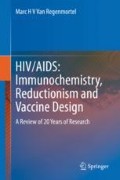Abstract
It is common parlance to refer to viral antigens and their epitopes as immunogens capable of producing antibodies (Abs) against the virus that harbours them. Words have an insiduous capacity to fashion our thinking and terms like immunogen and immunogenicity do suggest that epitopes are able to generate immune responses, although they only trigger in the host a series of reactions with B-cell receptors that eventually leads to the immune system (IS) producing a variety of antibodies. Although everyone in the field is well aware that antigens are different from immunogens, it seems that in many cases investigators do not use appropriate experimental tools for studying and controlling the immunogenicity of proteins rather than their antigenicity.
Vaccine, 2017, 35, 1985–1986.
Marc H V Van Regenmortel
Copyright © 2017 Elsevier
All rights reserved, used with permission
Access this chapter
Tax calculation will be finalised at checkout
Purchases are for personal use only
References
Berzofsky JA. Intrinsic and extrinsic factors in protein antigenic structure. Science. 1985;229:932–40.
Mascola JR, Haynes BF. HIV-1 neutralizing antibodies: understanding nature’s pathways. Immunol Rev. 2013;254:225–44.
Pejchal R, Wilson IA. Structure-based vaccine design in HIV: blind men and the elephant? Curr Pharm Des. 2010;16:3744–53.
Scherer EM, Leaman DP, Zwick MB, McMichael AJ, Burton DR. Aromatic residues at the edge of the antibody combining site facilitate viral glycoprotein recognition through membrane interactions. Proc Natl Acad Sci U S A. 2010;107:1529–34.
Stamatatos L, Pancera M, McGuire AT. Germline-targeting immunogens. Immunol Rev. 2017;275:203–16.
Tomaras GD, Plotkin SA. Complex immune correlates of protection in HIV-1 vaccine efficacy trials. Immunol Rev. 2017;275:245–61.
Van Regenmortel MHV. Two meanings of reverse vaccinology and the empirical nature of vaccine science. Vaccine. 2011a;29:7875.
Van Regenmortel MHV. Basic research in HIV vaccinology is hampered by reductionist thinking. Front Immunol. 2012b;3:194. https://doi.org/10.3389/fimmu.2012.00194.
Van Regenmortel MHV. Specificity, polyspecificity, and heterospecificity of antibody-antigen recognition. J Mol Recognit. 2014a;27:627–39.
Van Regenmortel MHV. An outdated notion of antibody specificity is one of the major detrimental assumptions of the structure-based reverse vaccinology paradigm, which prevented it from developing an effective HIV-1 vaccine. Front Immunol. 2014b;5:593. https://doi.org/10.3389/fimmu.1014.00593.
Van Regenmortel MHV. Structure-based reverse vaccinology failed in the case of HIV because it disregarded accepted immunological theory. Int J Mol Sci. 2016b;17:1591–625. https://doi.org/10.3390/ijms17091591.
Verkoczy L, Alt FW, Tian M. Human Ig knocking mice to study the development and regulation of broadly neutralizing antibodies. Immunol Rev. 2017;275:89–107.
Xiao X, Chen W, Feng Y, Zhu Z, Prabakaran P, Wang Y, Zhang MY, Longo NS, Dimitrov DS. Germline-like predecessors of broadly neutralizing antibodies lack measurable binding to HIV-1 envelope glycoproteins: implications for evasion of immune responses and design of vaccine immunogens. Biochem Biophys Res Commun. 2009;390:404–9.
Yu L, Guan Y. Immunologic basis for long HCDR3s in broadly neutralizing antibodies against HIV-1. Front Immunol. 2014;5:250.
Author information
Authors and Affiliations
Rights and permissions
Copyright information
© 2019 Springer Nature Switzerland AG
About this chapter
Cite this chapter
Van Regenmortel, M.H.V. (2019). Immune Systems Rather than Antigenic Epitopes Elicit and Produce Protective Antibodies Against HIV. In: HIV/AIDS: Immunochemistry, Reductionism and Vaccine Design. Springer, Cham. https://doi.org/10.1007/978-3-030-32459-9_22
Download citation
DOI: https://doi.org/10.1007/978-3-030-32459-9_22
Published:
Publisher Name: Springer, Cham
Print ISBN: 978-3-030-32458-2
Online ISBN: 978-3-030-32459-9
eBook Packages: Biomedical and Life SciencesBiomedical and Life Sciences (R0)

